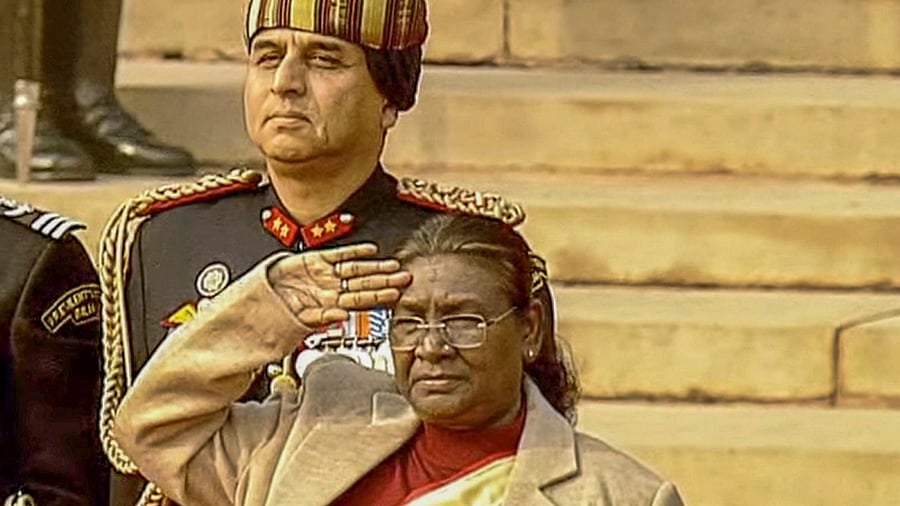
President Droupadi Murmu being accorded the national salute by the President’s Bodyguard.
Credit: PTI
The policy which limits recruitment to the President’s Bodyguard to three castes – Jat, Sikh and Rajput – has remained contentious and continues to trigger discussions around alleged biases in the process. The Delhi High Court is hearing a petition that challenges the policy on the ground that it violates Articles 14, 15 and 16 of the Constitution of India.
In response to a similar petition filed earlier in the Supreme Court, the Army had justified the policy citing functional requirements that include uniformity in “height, built (sic) and appearance” in the regiment. This recruitment policy is a byproduct of the eugenical Martial Race Theory (MRT) which sees people from the northern and the north-western parts of the Indian subcontinent as descendants of the ‘pure’ Aryan races, and considers other communities as not sufficiently ‘brave’ and ‘honourable’ to bear arms.
This recruitment policy is arbitrary in today’s world where the officers face escalating levels of difficulty to reach the upper echelons of the Army. Disqualifying a candidate on the basis of their caste and their inherited ‘honour’ is absurd. The scientific reasons cited behind the MRT represent the absurdity of the theory: people from the northern states are believed to be stronger and braver since the hot weather further south ‘degenerates one’s masculine traits’.
The right against discrimination is, in reality, three fundamental rights under the Constitution: 1) Article 14 and its right to equality which states that two equal groups cannot be treated unequally 2) Article 15 and its proscription of discrimination on the grounds of race, religion, caste, sex, place of birth or any one of them and 3) Article 16 and its guarantee of equal opportunity in public employment.
To decide when the right against discrimination is being breached, we consider: 1) the ‘intelligible differentia’ i.e. the basis used to differentiate one group from the others and 2) whether the classification has any ‘rational nexus’ with the objective sought to be achieved.
The Supreme Court has further held that we cannot accept a classification merely because the State has made it: we must test the classification against the principles of substantive equality which lies at the heart of Article 14 of the Constitution. In Sukanya Shantha v. Union of India, the Supreme Court tested the classification made by the prison manuals and rules (‘the rules’) of various states. They: 1) allocated ‘menial’ work such as cleaning and sweeping to those ‘who were accustomed to such duties’ 2) prohibited men from classes that have a ‘strong, natural tendency to escape’, i.e. men from wandering tribes, from serving as night watchmen and 3) required that cooking be done solely by people from the dominant castes.
The Supreme Court found these policies to be manifestly arbitrary and lacking any intelligible differentia. The Court held that caste could be the intelligible differentia only when it is used to create protective policies for the marginalised castes. It reiterated the mandate of Articles 15, 16 and 17 that caste cannot be used by the State to perpetuate further discrimination.
Martial Race Theory in India
The British first implemented the MRT in India. Influenced by the events of the Sepoy Mutiny, they adopted the MRT’s position that the ‘pure’ Aryans who invaded the weaker Dravidians were culturally and biologically at a superior level when it came to ‘bearing arms’. However, in India, caste, a social division of the same race, reigns supreme as the deciding order. When one form of hierarchy is transposed onto another, the direction of discrimination remains the same.
The recruitment policy followed for the President’s Bodyguard cannot be explained via the MRT alone. This is a policy that discriminates on the basis of caste and not just race or region. The petition by Gaurav Yadav – who moved the Delhi HC against the recruitment process – might be the first step in a larger, more complicated challenge to the Army’s recruitment policies and their links with caste.
Recent court decisions have started dismantling discriminatory recruitment practices that are prevalent within the Indian Army. A notable example is the case of Babita Puniya, where the Supreme Court held that the Army cannot have hiring/promotion practices that discriminate based on gender.
(The writer is a research associate at the Centre for Law and Policy Research)